Pyrazolo[1,5-a]pyrimidine as a Prominent Framework for Tropomyosin Receptor Kinase (Trk) Inhibitors—Synthetic Strategies and SAR Insights
Abstract
:1. Introduction
2. Synthetic Strategies
3. Pyrazolo[1,5-a]pyrimidine as TRK Inhibitors
4. Summary
5. Conclusions
Author Contributions
Funding
Institutional Review Board Statement
Informed Consent Statement
Data Availability Statement
Acknowledgments
Conflicts of Interest
Abbreviations
| PP | Pyrazolo[1,5-a]pyrimidine |
| TRK | Tropomyosin Receptor Kinases |
| SAR | Structure-Activity Relationship |
| FDA | Food and Drug Administration |
| NGF | Nerve Growth Factor |
| BDNF | Brain-Derived Neurotrophic Factor |
| NT3 | Neurotrophin-3 |
| AML | Acute Myeloid Leukemia |
| CNS | Central Nervous System |
| CDK | Cyclin-Dependent Kinases |
| RTK | receptor tyrosine kinases |
| EGFRs | Epidermal Growth Factor Receptors |
| FGFRs | Fibroblast Growth Factor Receptors |
| ALK | Anaplastic lymphoma kinase |
| ROS1 | ROS proto-oncogene 1, receptor tyrosine kinase |
References
- Huang, E.J.; Reichardt, L.F. Neurotrophins: Roles in Neuronal Development and Function. Annu. Rev. Neurosci. 2001, 24, 677–736. [Google Scholar] [CrossRef] [PubMed]
- Kozaki, R.; Yoshizawa, T.; Tsukamoto, K.; Kato, H.; Kawabata, K. Abstract 2954A: A Potent and Selective TRK Inhibitor ONO-5390556, Shows Potent Antitumor Activity against Both TRK-Rearranged Cancers and the Resistant Mutants. Cancer Res. 2016, 76, 2954A. [Google Scholar] [CrossRef]
- Morgan Huse, J.K. Review the Conformational Plasticity of Protein Kinases. Cell 2002, 109, 275–282. [Google Scholar] [CrossRef] [PubMed]
- Jiang, T.; Wang, G.; Liu, Y.; Feng, L.; Wang, M.; Liu, J.; Chen, Y.; Ouyang, L. Development of Small-Molecule Tropomyosin Receptor Kinase (TRK) Inhibitors for NTRK Fusion Cancers. Acta Pharm. Sin. B 2021, 11, 355–372. [Google Scholar] [CrossRef] [PubMed]
- Kalpan, D.R.; Martin-Zanca, D.; Parada, L.F. Tyrosine Phosphorylation and Tyrosine Kinase Activity of the Trk Proto-Oncogene Product Induced by NGF. Nature 1991, 350, 158–160. [Google Scholar]
- Klein, R.; Nanduri, V.; Jing, S.; Lamballe, F.; Tapley, P.; Bryant, S.; Cordon-Cardo, C.; Jones, K.R.; Reichardt, L.F.; Barbacid, M. The MB Tyrosine Protein Kinase Is a Receptor for Brain-Derived Neurotrophic Factor and Neurotrophin-3. Cell 1991, 65, 395–403. [Google Scholar] [CrossRef]
- Kakizawa, S. Neurotrophin-3. In Handbook of Hormones (Second Edition); Ando, H., Ukena, K., Nagata, S., Eds.; Academic Press: San Diego, CA, USA, 2021; pp. 483–485. ISBN 978-0-12-820649-2. [Google Scholar]
- Xu, X.; Song, L.; Li, Y.; Guo, J.; Huang, S.; Du, S.; Li, W.; Cao, R.; Cui, S. Neurotrophin-3 Promotes Peripheral Nerve Regeneration by Maintaining a Repair State of Schwann Cells after Chronic Denervation via the TrkC/ERK/c-Jun Pathway. J. Transl. Med. 2023, 21, 733. [Google Scholar] [CrossRef] [PubMed]
- Lozano-Ureña, A.; Frade, J.M. Differential Contribution of TrkB and P75NTR to BDNF-Dependent Self-Renewal, Proliferation, and Differentiation of Adult Neural Stem Cells. Front. Mol. Neurosci. 2023, 16, 1271820. [Google Scholar] [CrossRef]
- Huang, X.L.; Khan, M.I.; Wang, J.; Ali, R.; Ali, S.W.; Zahra, Q.-A.; Kazmi, A.; Lolai, A.; Huang, Y.L.; Hussain, A.; et al. Role of Receptor Tyrosine Kinases Mediated Signal Transduction Pathways in Tumor Growth and Angiogenesis—New Insight and Futuristic Vision. Int. J. Biol. Macromol. 2021, 180, 739–752. [Google Scholar] [CrossRef]
- Batool, Z.; Azfal, A.; Liaquat, L.; Sadir, S.; Nisar, R.; Inamullah, A.; Faiz Ghalib, A.U.; Haider, S. Receptor Tyrosine Kinases (RTKs): From Biology to Pathophysiology. In Receptor Tyrosine Kinases in Neurodegenerative and Psychiatric Disorders; Mansour, H.M., Khattab, M.M., El-khatib, A.S., Eds.; Academic Press: Cambridge, MA, USA, 2023; pp. 117–185. ISBN 978-0-443-18677-6. [Google Scholar]
- Cunningham, M.E.; Greene, L.A. A Function-Structure Model for NGF-Activated TRK. EMBO J. 1998, 17, 7282–7293. [Google Scholar] [CrossRef]
- Vaishnavi, A.; Le, A.T.; Doebele, R.C. TRKing down an Old Oncogene in a New Era of Targeted Therapy. Cancer Discov. 2015, 5, 25–34. [Google Scholar] [CrossRef] [PubMed]
- Amatu, A.; Sartore-Bianchi, A.; Siena, S. NTRK Gene Fusions as Novel Targets of Cancer Therapy across Multiple Tumour Types. Open 2016, 1, 23. [Google Scholar] [CrossRef] [PubMed]
- Pulciani, S.; Santos, E.; Lauver, A.V.; Long, L.K.; Aaronson, S.A. Oncogene in Solid Human Tumours. Nature 1982, 300, 539–542. [Google Scholar] [CrossRef]
- Martin-Zanca, D.; Hughes, S.H.; Barbacid, M. A Human Oncogene Formed by the Fusion of Truncated Tropomyosin and Protein Tyrosine Kinase Sequences. Nature 1986, 319, 743–748. [Google Scholar] [CrossRef]
- Amatu, A.; Sartore-Bianchi, A.; Bencardino, K.; Pizzutilo, E.G.; Tosi, F.; Siena, S. Tropomyosin Receptor Kinase (TRK) Biology and the Role of NTRK Gene Fusions in Cancer. Ann. Oncol. 2019, 30, VIII5–VIII15. [Google Scholar] [CrossRef]
- Pestana, R.C.; Sen, S.; Hobbs, B.P.; Hong, D.S. Histology-Agnostic Drug Development—Considering Issues beyond the Tissue. Nat. Rev. Clin. Oncol. 2020, 17, 555–568. [Google Scholar] [CrossRef] [PubMed]
- Maristella Bungaro, E.G. NTRK1/2/3: Biology, Detection and Therapy. Precis Cancer Med. 2024, 1–13. [Google Scholar]
- Forsythe, A.; Zhang, W.; Phillip Strauss, U.; Fellous, M.; Korei, M.; Keating, K. A Systematic Review and Meta-Analysis of Neurotrophic Tyrosine Receptor Kinase Gene Fusion Frequencies in Solid Tumors. Ther. Adv. Med. Oncol. 2020, 12, 1758835920975613. [Google Scholar] [CrossRef]
- Somwar, R.; Hofmann, N.E.; Smith, B.; Odintsov, I.; Vojnic, M.; Linkov, I.; Tam, A.; Khodos, I.; Mattar, M.S.; de Stanchina, E.; et al. NTRK Kinase Domain Mutations in Cancer Variably Impact Sensitivity to Type I and Type II Inhibitors. Commun. Biol. 2020, 3, 776. [Google Scholar] [CrossRef]
- Theik, N.W.Y.; Muminovic, M.; Alvarez-Pinzon, A.M.; Shoreibah, A.; Hussein, A.M.; Raez, L.E. NTRK Therapy among Different Types of Cancers, Review and Future Perspectives. Int. J. Mol. Sci. 2024, 25, 2366. [Google Scholar] [CrossRef]
- Iannantuono, G.M.; Riondino, S.; Sganga, S.; Rosenfeld, R.; Guerriero, S.; Carlucci, M.; Capotondi, B.; Torino, F.; Roselli, M. NTRK Gene Fusions in Solid Tumors and TRK Inhibitors: A Systematic Review of Case Reports and Case Series. J. Pers. Med. 2022, 12, 1819. [Google Scholar] [CrossRef]
- Xiang, S.; Lu, X. Selective Type II TRK Inhibitors Overcome XDFG Mutation Mediated Acquired Resistance to the Second-Generation Inhibitors Selitrectinib and Repotrectinib. Acta Pharm. Sin. B 2024, 14, 517–532. [Google Scholar] [CrossRef] [PubMed]
- Lim, J.S.J.; Tan, D.S.P. TRK Inhibitors: Managing on-Target Toxicities. Ann. Oncol. 2020, 31, 1109–1111. [Google Scholar] [CrossRef]
- Cocco, E.; Scaltriti, M.; Drilon, A. NTRK Fusion-Positive Cancers and TRK Inhibitor Therapy. Nat. Rev. Clin. Oncol. 2018, 15, 731–747. [Google Scholar] [CrossRef] [PubMed]
- Chen, S.; Schneider, B.; Nagel, S.; Geffers, R.; Kaufmann, M.; Quentmeier, H.; Drexler, H.G.; MacLeod, R.A.F. Spliceosomal Targeting in Acute Myeloid Leukemia Cells with ETV6-NTRK3 Fusion. Blood 2009, 114, 5042. [Google Scholar] [CrossRef]
- Enkavi, G.; Girych, M.; Moliner, R.; Vattulainen, I.; Castrén, E. TrkB Transmembrane Domain: Bridging Structural Understanding with Therapeutic Strategy. Trends Biochem. Sci. 2024, 49, 445–456. [Google Scholar] [CrossRef]
- Regua, A.T.; Aguayo, N.R.; Jalboush, S.A.; Doheny, D.L.; Manore, S.G.; Zhu, D.; Wong, G.L.; Arrigo, A.; Wagner, C.J.; Yu, Y.; et al. Trka Interacts with and Phosphorylates Stat3 to Enhance Gene Transcription and Promote Breast Cancer Stem Cells in Triple-Negative and Her2-Enriched Breast Cancers. Cancers 2021, 13, 2340. [Google Scholar] [CrossRef] [PubMed]
- Lange, A.M.; Lo, H.W. Inhibiting TRK Proteins in Clinical Cancer Therapy. Cancers 2018, 10, 105. [Google Scholar] [CrossRef]
- Reuther, G.W.; Lambert, Q.T.; Caligiuri, M.A.; Channing, A.; Der, J. Identification and Characterization of an Activating TrkA Deletion Mutation in Acute Myeloid Leukemia. Mol. Cell. Biol. 2000, 20, 8655–8666. [Google Scholar] [CrossRef]
- Roccato, E.; Miranda, C.; Ranzi, V.; Gishizki, M.; Pierotti, M.A.; Greco, A. Biological Activity of the Thyroid TRK-T3 Oncogene Requires Signalling through Shc. Br. J. Cancer 2002, 87, 645–653. [Google Scholar] [CrossRef]
- Ranzi, V.; Meakin, S.O.; Miranda, C.; Mondellini, P.; Pierotti, M.A.; Greco, A. The Signaling Adapters Fibroblast Growth Factor Receptor Substrate 2 and 3 Are Activated by the Thyroid TRK Oncoproteins. Endocrinology 2003, 144, 922–928. [Google Scholar] [CrossRef]
- Lee, Y.C.; Chen, J.Y.; Huang, C.J.; Chen, H.S.; Yang, A.H.; Hang, J.F. Detection of NTRK1/3 Rearrangements in Papillary Thyroid Carcinoma Using Immunohistochemistry, Fluorescent In Situ Hybridization, and Next-Generation Sequencing. Endocr. Pathol. 2020, 31, 348–358. [Google Scholar] [CrossRef]
- Wu, S.; Liu, Y.; Shi, X.; Zhou, W.; Zeng, X. Elaboration of NTRK-Rearranged Colorectal Cancer: Integration of Immunoreactivity Pattern, Cytogenetic Identity, and Rearrangement Variant. Dig. Liver Dis. 2023, 55, 1757–1764. [Google Scholar] [CrossRef]
- Kang, M.; Chong, K.Y.; Hartwich, T.M.P.; Bi, F.; Witham, A.K.; Patrick, D.; Morrisson, M.J.; Cady, S.L.; Cerchia, A.P.; Kelk, D.; et al. Ovarian BDNF Promotes Survival, Migration, and Attachment of Tumor Precursors Originated from P53 Mutant Fallopian Tube Epithelial Cells. Oncogenesis 2020, 9, 55. [Google Scholar] [CrossRef] [PubMed]
- Dionne, C.A.; Camoratto, A.M.; Jam, J.P.; Emerson, E.; Neff, N.; Vaught, J.L.; Murakata, C.; Djakiew, D.; Lamb, J.; Bova, S.; et al. Cell Cycle-Independent Death of Prostate Adenocarcinoma Is Induced by the Trk Tyrosine Kinase Inhibitor CEP-751 (KT6587)’. Clin. Cancer Res. 1998, 4, 1887–1898. [Google Scholar] [PubMed]
- Dang, C.; Zhang, Y.; Ma, Q.; Shimahara, Y. Expression of Nerve Growth Factor Receptors Is Correlated with Progression and Prognosis of Human Pancreatic Cancer. J. Gastroenterol. Hepatol. 2006, 21, 850–858. [Google Scholar] [CrossRef] [PubMed]
- Marchetti, A.; Felicioni, L.; Pelosi, G.; Del Grammastro, M.; Fumagalli, C.; Sciarrotta, M.; Malatesta, S.; Chella, A.; Barassi, F.; Mucilli, F.; et al. Frequent Mutations in the Neurotrophic Tyrosine Receptor Kinase Gene Family in Large Cell Neuroendocrine Carcinoma of the Lung. Hum. Mutat. 2008, 29, 609–616. [Google Scholar] [CrossRef]
- Meng, Y.; Huang, K.; Shi, M.; Huo, Y.; Han, L.; Liu, B.; Li, Y. Research Advances in the Role of the Tropomyosin Family in Cancer. Int. J. Mol. Sci. 2023, 24, 13295. [Google Scholar] [CrossRef]
- Ross, J.S.; Wang, K.; Gay, L.; Al-Rohil, R.; Rand, J.V.; Jones, D.M.; Lee, H.J.; Sheehan, C.E.; Otto, G.A.; Palmer, G.; et al. New Routes to Targeted Therapy of Intrahepatic Cholangiocarcinomas Revealed by Next-Generation Sequencing. Oncologist 2014, 19, 235–242. [Google Scholar] [CrossRef]
- Shi, E.; Chmielecki, J.; Tang, C.M.; Wang, K.; Heinrich, M.C.; Kang, G.; Corless, C.L.; Hong, D.; Fero, K.E.; Murphy, J.D.; et al. FGFR1 and NTRK3 Actionable Alterations in “Wild-Type” Gastrointestinal Stromal Tumors. J. Transl. Med. 2016, 14, 339. [Google Scholar] [CrossRef]
- Hechtman, J.F.; Benayed, R.; Hyman, D.M.; Drilon, A.; Zehir, A.; Frosina, D.; Arcila, M.E.; Dogan, S.; Klimstra, D.S.; Ladanyi, M.; et al. Pan-Trk Immunohistochemistry Is an Efficient and Reliable Screen for the Detection of NTRK Fusions. Am. J. Surg. Pathol. 2017, 41, 1547–1551. [Google Scholar] [CrossRef] [PubMed]
- Pishvaian, M.J.; Garrido-Laguna, I.; Liu, S.V.; Multani, P.S.; Chow-Maneval, E.; Rolfo, C. Entrectinib in TRK and ROS1 Fusion-Positive Metastatic Pancreatic Cancer. Precis. Oncol. 2018, 2, 1–7. [Google Scholar] [CrossRef] [PubMed]
- Freund-Michel, V.; Frossard, N. The Nerve Growth Factor and Its Receptors in Airway Inflammatory Diseases. Pharmacol. Ther. 2008, 117, 52–76. [Google Scholar] [CrossRef] [PubMed]
- Hu, V.Y.; Zvara, P.; Dattilio, A.; Redman, T.L.; Allen, S.J.; Dawbarn, D.; Stroemer, R.P.; Vizzard, M.A. Decrease in Bladder Overactivity with REN1820 in Rats with Cyclophosphamide Induced Cystitis. J. Urol. 2005; 173, pp. 1016–1021. [Google Scholar]
- Di Mola, F.F.; Friess, H.; Zhu, Z.W.; Koliopanos, A.; Bley, T.; Sebastiano, D.; Innocenti, P.; Zimmermann, A.; Büchler, M.W. Nerve Growth Factor and Trk High Affinity Receptor (TrkA) Gene Expression in Inflammatory Bowel Disease. Gut 2000, 46, 670–678. [Google Scholar] [CrossRef] [PubMed]
- Dou, Y.C.; Hagströmer, L.; Emtestam, L.; Johansson, O. Increased Nerve Growth Factor and Its Receptors in Atopic Dermatitis: An Immunohistochemical Study. Arch. Dermatol. Res. 2006, 298, 31–37. [Google Scholar] [CrossRef] [PubMed]
- Raychaudhuri, S.P.; Sanyal, M.; Weltman, H.; Kundu, S.; Ãw, R. K252a, a High-Affinity Nerve Growth Factor Receptor Blocker, Improves Psoriasis: An In Vivo Study Using the Severe Combined Immunodeficient Mouse-Human Skin Model. J. Invest Dermatol. 2004, 122, 812–819. [Google Scholar] [CrossRef]
- Hirose, M.; Kuroda, Y.; Murata, E. NGF/TrkA Signaling as a Therapeutic Target for Pain. Pain Pract. 2016, 16, 175–182. [Google Scholar] [CrossRef] [PubMed]
- Savaskan, E.; Müller-Spahn, F.; Olivieri, G.; Bruttel, S.; Otten, U.; Rosenberg, C.; Hulette, C.; Hock, C.; Savaskan, E. Alterations in Trk A, Trk B and Trk C Receptor Immunoreactivities in Parietal Cortex and Cerebellum in Alzheimer’s Disease. Eur. Neurol. 2000, 44, 172–180. [Google Scholar] [CrossRef]
- Prencipe, G.; Minnone, G.; Strippoli, R.; De Pasquale, L.; Petrini, S.; Caiello, I.; Manni, L.; De Benedetti, F.; Bracci-Laudiero, L. Nerve Growth Factor Downregulates Inflammatory Response in Human Monocytes through TrkA. J. Immunol. 2014, 192, 3345–3354. [Google Scholar] [CrossRef]
- Numakawa, T.; Odaka, H. Chapter 3—Roles of Trk Receptors, Tyrosine Kinase Receptors for Neurotrophins, in the Developing CNS. In Receptor Tyrosine Kinases in Neurodegenerative and Psychiatric Disorders; Mansour, H.M., Khattab, M.M., El-khatib, A.S., Eds.; Academic Press: Cambridge, MA, USA, 2023; pp. 79–115. ISBN 978-0-443-18677-6. [Google Scholar]
- Stoleru, B.; Madalina Popescu, A.; Elise Tache, T.; Maria Neamtu, O.; Emami, G.; Tataranu, L.G.; Buteica, A.S.; Dricu, A.; Purcaru, S.O. Tropomyosin-Receptor-Kinases Signalling in the Nervous System. Maedica-A J. Clin. Med. 2013, 8, 43–48. [Google Scholar]
- Laetsch, T.W.; Hong, D.S. Tropomyosin Receptor Kinase Inhibitors for the Treatment of TRK Fusion Cancer. Clin. Cancer Res. 2021, 27, 4974–4982. [Google Scholar] [CrossRef] [PubMed]
- Yan, W.; Lakkaniga, N.R.; Carlomagno, F.; Santoro, M.; McDonald, N.Q.; Lv, F.; Gunaganti, N.; Frett, B.; Li, H.Y. Insights into Current Tropomyosin Receptor Kinase (TRK) Inhibitors: Development and Clinical Application. J. Med. Chem. 2019, 62, 1731–1760. [Google Scholar] [CrossRef] [PubMed]
- Roviello, G.; D’Angelo, A.; Sciortino, M.; Mini, E.; Nobili, S.; De Logu, F.; Massi, D. TRK Fusion Positive Cancers: From First Clinical Data of a TRK Inhibitor to Future Directions. Crit. Rev. Oncol. Hematol. 2020, 152, 103011. [Google Scholar] [CrossRef] [PubMed]
- Bailey, J.J.; Schirrmacher, R.; Farrell, K.; Bernard-Gauthier, V. Tropomyosin Receptor Kinase Inhibitors: An Updated Patent Review for 2010-2016–Part I. Expert Opin. Ther. Pat. 2017, 27, 733–751. [Google Scholar] [CrossRef] [PubMed]
- Drilon, A.; Nagasubramanian, R.; Blake, J.F.; Ku, N.; Tuch, B.B.; Ebata, K.; Smith, S.; Lauriault, V.; Kolakowski, G.R.; Brandhuber, B.J.; et al. A Next-Generation TRK Kinase Inhibitor Overcomes Acquired Resistance to Prior Trk Kinase Inhibition in Patients with TRK Fusion-Positive Solid Tumors. Cancer Discov. 2017, 7, 963–972. [Google Scholar] [CrossRef] [PubMed]
- Drilon, A.; Ou, S.H.I.; Cho, B.C.; Kim, D.W.; Lee, J.; Lin, J.J.; Zhu, V.W.; Ahn, M.J.; Camidge, D.R.; Nguyen, J.; et al. Repotrectinib (Tpx-0005) Is a next-Generation Ros1/Trk/Alk Inhibitor That Potently Inhibits Ros1/Trk/Alk Solvent-Front Mutations. Cancer Discov. 2018, 8, 1227–1236. [Google Scholar] [CrossRef] [PubMed]
- Cherukupalli, S.; Karpoormath, R.; Chandrasekaran, B.; Hampannavar, G.A.; Thapliyal, N.; Palakollu, V.N. An Insight on Synthetic and Medicinal Aspects of Pyrazolo[1,5-a]Pyrimidine Scaffold. Eur. J. Med. Chem. 2017, 126, 298–352. [Google Scholar] [CrossRef] [PubMed]
- Chauhan, M.; Kumar, R. Medicinal Attributes of Pyrazolo[3,4-d]Pyrimidines: A Review. Bioorg. Med. Chem. 2013, 21, 5657–5668. [Google Scholar] [CrossRef] [PubMed]
- Ismail, N.S.M.; Ali, G.M.E.; Ibrahim, D.A.; Elmetwali, A.M. Medicinal Attributes of Pyrazolo[1,5-a]Pyrimidine Based Scaffold Derivatives Targeting Kinases as Anticancer Agents. Futur. J. Pharm. Sci. 2016, 2, 60–70. [Google Scholar] [CrossRef]
- Rashad, A.E.; Abdelmegid, M.; Shamroukh, A.H.; Abdelmegeid, F.M. The Chemistry of Pyrazolopyrimidines and Their Applications. Org. Chem. Ind. J. 2014, 10, 224–250. [Google Scholar]
- Salem, M.A.; Helal, M.H.; Gouda, M.A.; Abd EL-Gawad, H.H.; Shehab, M.A.M.; El-Khalafawy, A. Recent Synthetic Methodologies for Pyrazolo[1,5-a]Pyrimidine. Synth. Commun. 2019, 49, 1750–1776. [Google Scholar] [CrossRef]
- Fraley, M.E.; Hoffman, W.F.; Rubino, R.S.; Hungate, R.W.; Tebben, A.J.; Rutledge, R.Z.; Mcfall, R.C.; Huckle, W.R.; Kendall, R.L.; Coll, K.E.; et al. Synthesis and Initial SAR Studies of 3,6-Disubstituted Pyrazolo[1,5-a]Pyrimidines: A New Class of KDR Kinase Inhibitors. Bioorg. Med. Chem. Lett. 2002, 12, 2767–2770. [Google Scholar] [CrossRef] [PubMed]
- Abu Elmaati, T.M.; El-Taweel, F.M.A. Routes to Pyrazolo[3,4-e][1,4]Thiazepine, Pyrazolo[1,5-a]Pyrimidine and Pyrazole Derivatives. J. Chin. Chem. Soc. 2003, 50, 413–418. [Google Scholar] [CrossRef]
- Compton, D.R.; Carlson, K.E.; Katzenellenbogen, J.A. Pyrazolo[1,5-a]Pyrimidines as Estrogen Receptor Ligands: Defining the Orientation of a Novel Heterocyclic Core. Bioorg. Med. Chem. Lett. 2004, 14, 5681–5684. [Google Scholar] [CrossRef] [PubMed]
- Li, J.; Zhao, Y.F.; Zhao, X.L.; Yuan, X.Y.; Gong, P. Synthesis and Anti-Tumor Activities of Novel Pyrazolo[1,5-a]Pyrimidines. Arch. Pharm. 2006, 339, 593–597. [Google Scholar] [CrossRef] [PubMed]
- Paruch, K.; Dwyer, M.P.; Alvarez, C.; Brown, C.; Chan, T.Y.; Doll, R.J.; Keertikar, K.; Knutson, C.; McKittrick, B.; Rivera, J.; et al. Pyrazolo[1,5-a]Pyrimidines as Orally Available Inhibitors of Cyclin-Dependent Kinase 2. Bioorg. Med. Chem. Lett. 2007, 17, 6220–6223. [Google Scholar] [CrossRef]
- Frey, R.R.; Curtin, M.L.; Albert, D.H.; Glaser, K.B.; Pease, L.J.; Soni, N.B.; Bouska, J.J.; Reuter, D.; Stewart, K.D.; Marcotte, P.; et al. 7-Aminopyrazolo[1,5-a]Pyrimidines as Potent Multitargeted Receptor Tyrosine Kinase Inhibitors. J. Med. Chem. 2008, 51, 3777–3787. [Google Scholar] [CrossRef]
- Gommermann, N.; Buehlmayer, P.; Von Matt, A.; Breitenstein, W.; Masuya, K.; Pirard, B.; Furet, P.; Cowan-Jacob, S.W.; Weckbecker, G. New Pyrazolo[1,5a]Pyrimidines as Orally Active Inhibitors of Lck. Bioorg. Med. Chem. Lett. 2010, 20, 3628–3631. [Google Scholar] [CrossRef] [PubMed]
- El-Enany, M.M.; Kamel, M.M.; Khalil, O.M.; El-Nassan, H.B. Synthesis and Antitumor Activity of Novel Pyrazolo[1,5-a]Pyrimidine Derivatives. Eur. J. Chem. 2011, 2, 331–336. [Google Scholar] [CrossRef]
- Ivachtchenko, A.V.; Golovina, E.S.; Kadieva, M.G.; Kysil, V.M.; Mitkin, O.D.; Tkachenko, S.E.; Okun, I.M. Synthesis and Structure-Activity Relationship (SAR) of (5,7-Disubstituted 3-Phenylsulfonyl-Pyrazolo[1,5-a]Pyrimidin-2-Yl)-Methylamines as Potent Serotonin 5-HT 6 Receptor (5-HT 6R) Antagonists. J. Med. Chem. 2011, 54, 8161–8173. [Google Scholar] [CrossRef]
- Kosugi, T.; Mitchell, D.R.; Fujino, A.; Imai, M.; Kambe, M.; Kobayashi, S.; Makino, H.; Matsueda, Y.; Oue, Y.; Komatsu, K.; et al. Mitogen-Activated Protein Kinase-Activated Protein Kinase 2 (MAPKAP-K2) as an Anti-inflammatory Target: Discovery and in Vivo Activity of Selective Pyrazolo[1,5-a]Pyrimidine Inhibitors Using a Focused Library and Structure-Based Optimization Approach. J. Med. Chem. 2012, 55, 6700–6715. [Google Scholar] [CrossRef]
- Dwyer, M.P.; Keertikar, K.; Paruch, K.; Alvarez, C.; Labroli, M.; Poker, C.; Fischmann, T.O.; Mayer-Ezell, R.; Bond, R.; Wang, Y.; et al. Discovery of Pyrazolo[1,5-a]Pyrimidine-Based Pim Inhibitors: A Template-Based Approach. Bioorg. Med. Chem. Lett. 2013, 23, 6178–6182. [Google Scholar] [CrossRef]
- Devi, A.S.; Kaping, S.; Vishwakarma, J.N. A Facile Environment-Friendly One-Pot Two-Step Regioselective Synthetic Strategy for 3,7-Diarylpyrazolo[1,5-a]Pyrimidines Related to Zaleplon and 3,6-Diarylpyrazolo[1,5-a]Pyrimidine-7-Amines Assisted by KHSO4 in Aqueous Media. Mol. Divers. 2015, 19, 759–771. [Google Scholar] [CrossRef]
- Haas, J.; Andrews, S.W.; Jiang, Y.; Zhang, G. Substituted Pyrazolo[1,5-a]Pyrimidine Compounds as TRK Kinase Inhibitors. WO 2010048314, 29 April 2010. [Google Scholar]
- Allen, S.; Andrews, S.S.; Condroski, K.R.; Haas, J.; Huang, L.; Jiang, Y.; Kercher, T.; Seo, J. Substituted Pyrazolo [1,5-a]Pyrimidine Compounds as TRK Kinase Inhibitors. WO 2011006074, 13 January 2011. [Google Scholar]
- Andrews, S.W.; Condroski, K.R.; Haas, J.; Jiang, Y.; Kolakowski, G.R.; Seo, J.; Yang, H.-W.; Zhao, Q. Macrocyclic Compounds as TRK Kinase Inhibitors. WO 2011146336, 24 November 2011. [Google Scholar]
- Kim, M.; Lee, C.; Lee, G.; Yoon, C.; Seo, J.; Kim, J.H.; Lee, M.; Jeong, H.; Choi, H.; Jung, M.E.; et al. Fused Ring Heteroaryl Compounds and Their Use as Trk Inhibitors. WO 2016097869, 4 August 2016. [Google Scholar]
- Pal, K.; Ciblat, S.; Albert, V.; Bruneau-Latour, N.; Boudreault, J. 5-(2-(2,5-Difluorophenyl)Pyrrolidin-1-Yl)-3-(1H-Pyrazol-1-Yl)Pyrazolo[1,5-a]Pyrimidine Derivatives and Related Compounds as Trk Kinase Inhibitors for Treating Cancer. WO 2019118584, 20 June 2019. [Google Scholar]
- Wenglowsky, S.M.; Miduturu, C.V.; Neil Bifulco, J.R.; Kim, J.L. Compounds and Compositions for Treating Disorders to NTRK. US 10370379B2, 6 August 2019. [Google Scholar]
- Lin, J.; Ying, Y.; Liao, J.; Zhang, X.; Li, Z.; Yuan, J.; Jia, W.; Wang, W. Compound Having Macrocyclic Molecular Structure and Use Thereof. WO 2019149131, 8 August 2019. [Google Scholar]
- Liu, H.; Tan, H.; He, C.; Wang, X.; Liu, Q.; Li, Z.; Zhou, Z.; Gao, Y.; Jiang, L.; Linghu, L.; et al. Substituted (2-Azabicyclo [3.1.0] Hexan-2-Yl) Pyrazolo [1, 5-a] Pyrimidine and Imidazo[1, 2-b] Pyridazine Compounds as Trk Kinases Inhibitors. WO 2019174598, 19 September 2019. [Google Scholar]
- Cui, J.J.; LI, Y.; Rogers, E.W.; Zhai, D.; Ung, J. Macrocycle Kinase Inhibitors. US 10689400B2, 23 June 2020. [Google Scholar]
- Zhu, L.; Hu, Y.; Wu, W.; Dai, L.; Duan, X.; Yang, Y.; Sun, Y.; Han, Y.; Peng, Y.; Kong, F.; et al. Amino Pyrazolopyrimidine Used as Neurotrophic Tyrosine Kinase Receptor Inhibitors. US 10829492B2, 10 October 2020. [Google Scholar]
- Wang, Y.; Zhao, J. Substituted Pyrazolo[1,5-a]pyrimidine Macrocyclic Compound. EP 3744723A1, 2 December 2020. [Google Scholar]
- Wang, J.; Zhang, Y.; Sun, J.; Chen, S. Pyrazolopyrimidine Derivative as Selective Trk Inhibitor. US 20210403485 A1, 30 December 2021. [Google Scholar]
- Wang, J.; Sun, J.; Zhu, W.; Zhang, Y.; Li, J.L.; Chen, S. Pyrazolopyrimidine Derivatives and Use Thereof. US 11,464,780 B2, 11 October 2022. [Google Scholar]
- Li, P.; Cai, S.; Zhao, T.; Xu, L.; Guan, D.; Li, J.; Zhou, J.; Zhang, H. Design, Synthesis and Biological Evaluation of Macrocyclic Derivatives as TRK Inhibitors. Bioorg. Med. Chem. Lett. 2021, 53, 128409. [Google Scholar] [CrossRef] [PubMed]
- Zhang, Y.; Liu, Y.; Zhou, Y.; Zhang, Q.; Han, T.; Tang, C.; Fan, W. Pyrazolo[1,5-a]Pyrimidine Based Trk Inhibitors: Design, Synthesis, Biological Activity Evaluation. Bioorg. Med. Chem. Lett. 2021, 31, 127712. [Google Scholar] [CrossRef]
- Liu, Z.; Yu, P.; Dong, L.; Wang, W.; Duan, S.; Wang, B.; Gong, X.; Ye, L.; Wang, H.; Tian, J. Discovery of the Next-Generation Pan-TRK Kinase Inhibitors for the Treatment of Cancer. J. Med. Chem. 2021, 64, 10286–10296. [Google Scholar] [CrossRef]
- Gong, Y.; Wu, F.X.; Wang, M.S.; Xu, H.C.; Zhuo, L.S.; Yang, G.F.; Huang, W. Discovery of 3-Pyrazolyl-Substituted Pyrazolo[1,5-a]Pyrimidine Derivatives as Potent TRK Inhibitors to Overcome Clinically Acquired Resistance. Eur. J. Med. Chem. 2022, 241, 114654. [Google Scholar] [CrossRef] [PubMed]
- Fan, Y.; Zhang, Y.; Liu, Y.; Jiang, H.; Zhou, Y.; Tang, C.; Fan, W. Pyrazolo[1,5-a]Pyrimidine Derivatives of the Second-Generation TRK Inhibitor: Design, Synthesis and Biological Evaluation. Bioorg. Med. Chem. Lett. 2022, 63, 128646. [Google Scholar] [CrossRef] [PubMed]
- Al-Qadhi, M.A.; Allam, H.A.; Fahim, S.H.; Yahya, T.A.A.; Ragab, F.A.F. Design and Synthesis of Certain 7-Aryl-2-Methyl-3-Substituted Pyrazolo{1,5-a}Pyrimidines as Multikinase Inhibitors. Eur. J. Med. Chem. 2023, 262, 115918. [Google Scholar] [CrossRef]
- Metwally, N.H.; Deeb, E.A.; Hasani, I.W. Synthesis, Anticancer Evaluation, Molecular Docking and ADME Study of Novel Pyrido[4ʹ,3ʹ:3,4]Pyrazolo[1,5-a]Pyrimidines as Potential Tropomyosin Receptor Kinase A (TrKA) Inhibitors. BMC Chem. 2024, 18, 68. [Google Scholar] [CrossRef]
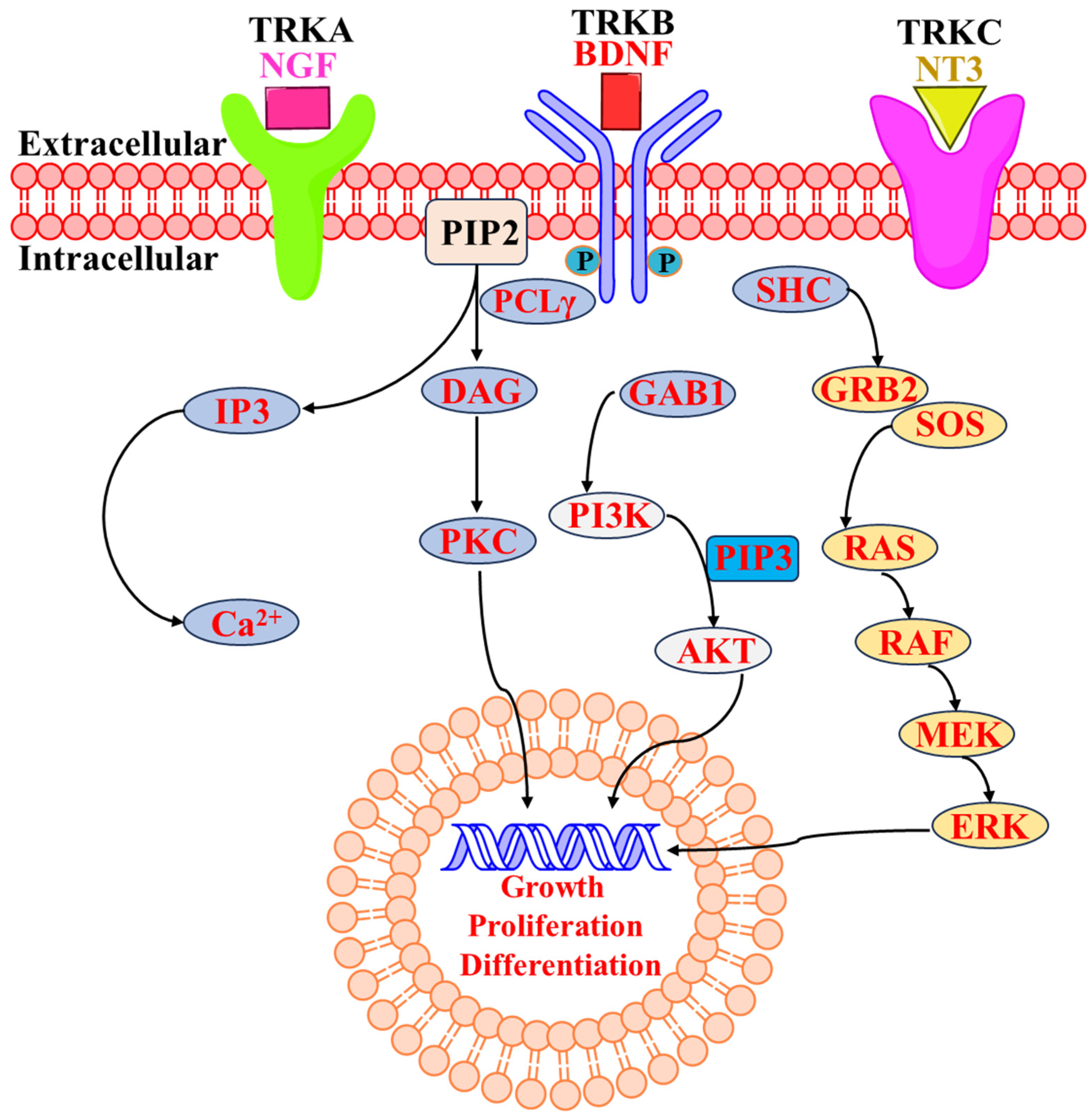
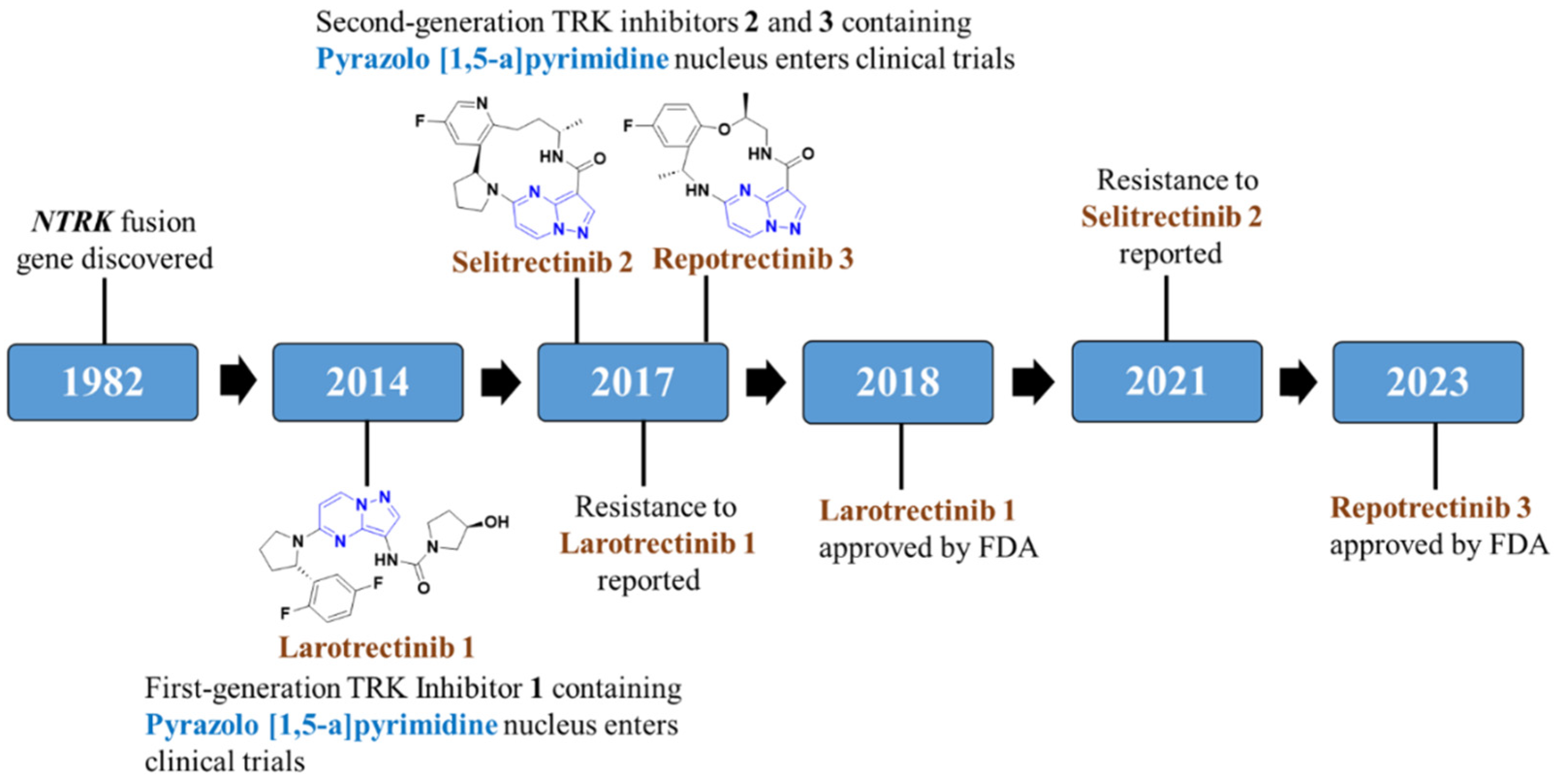





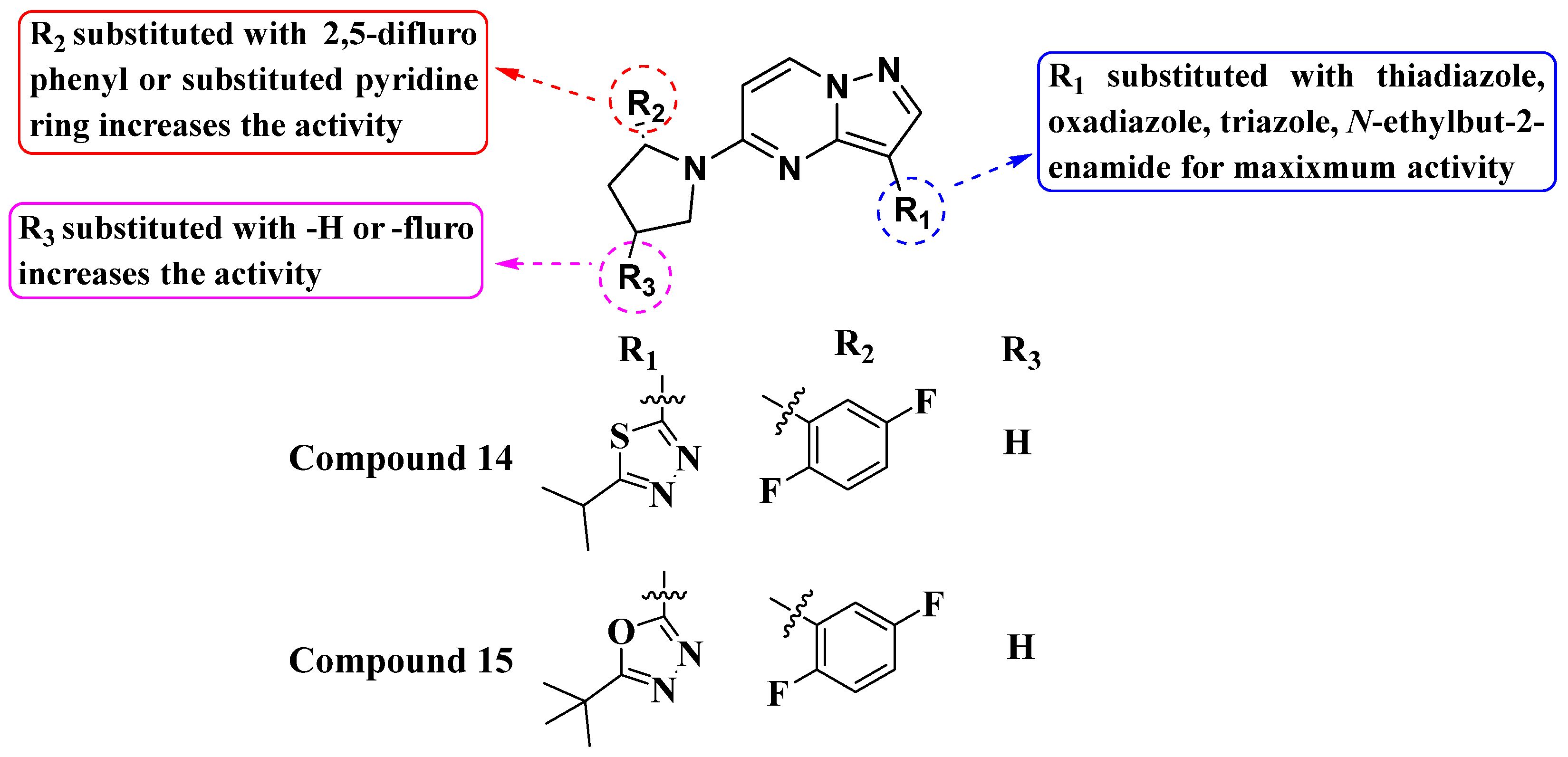
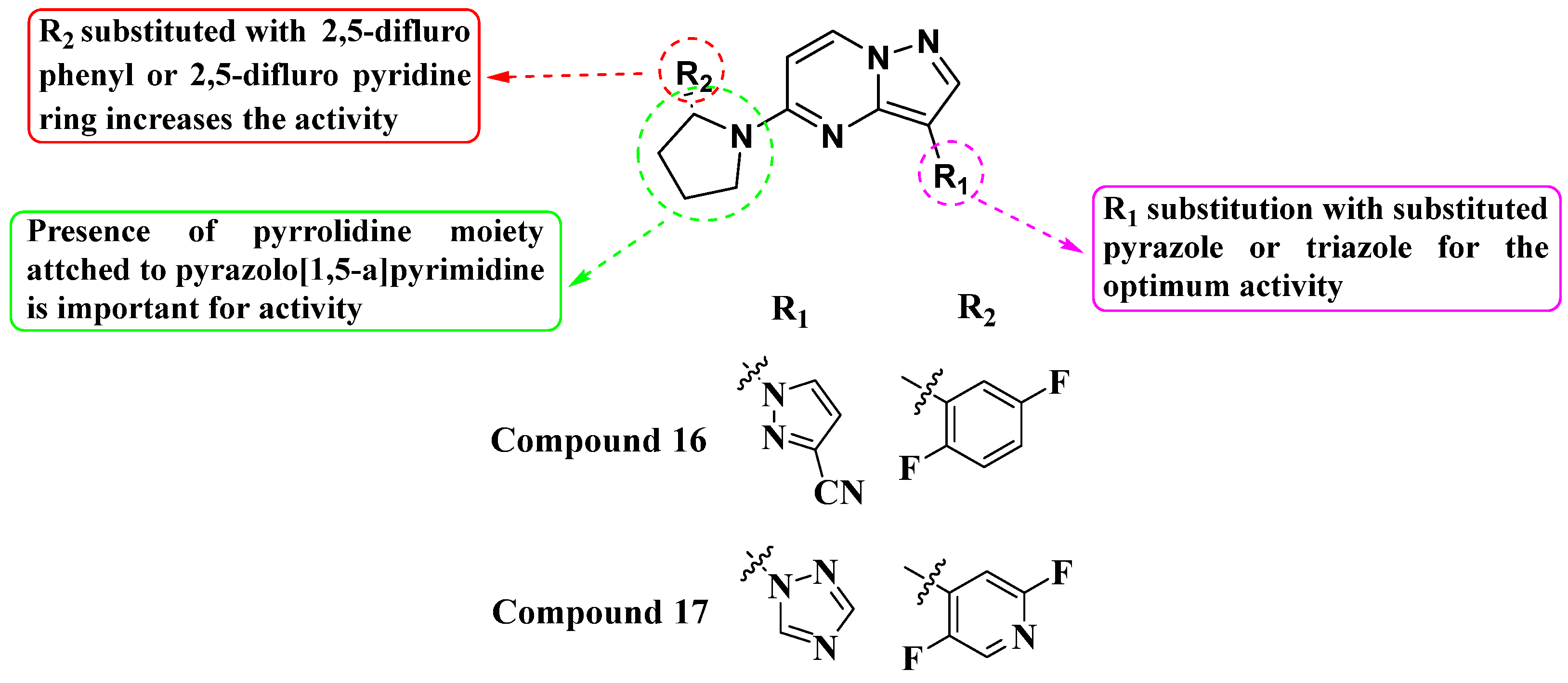
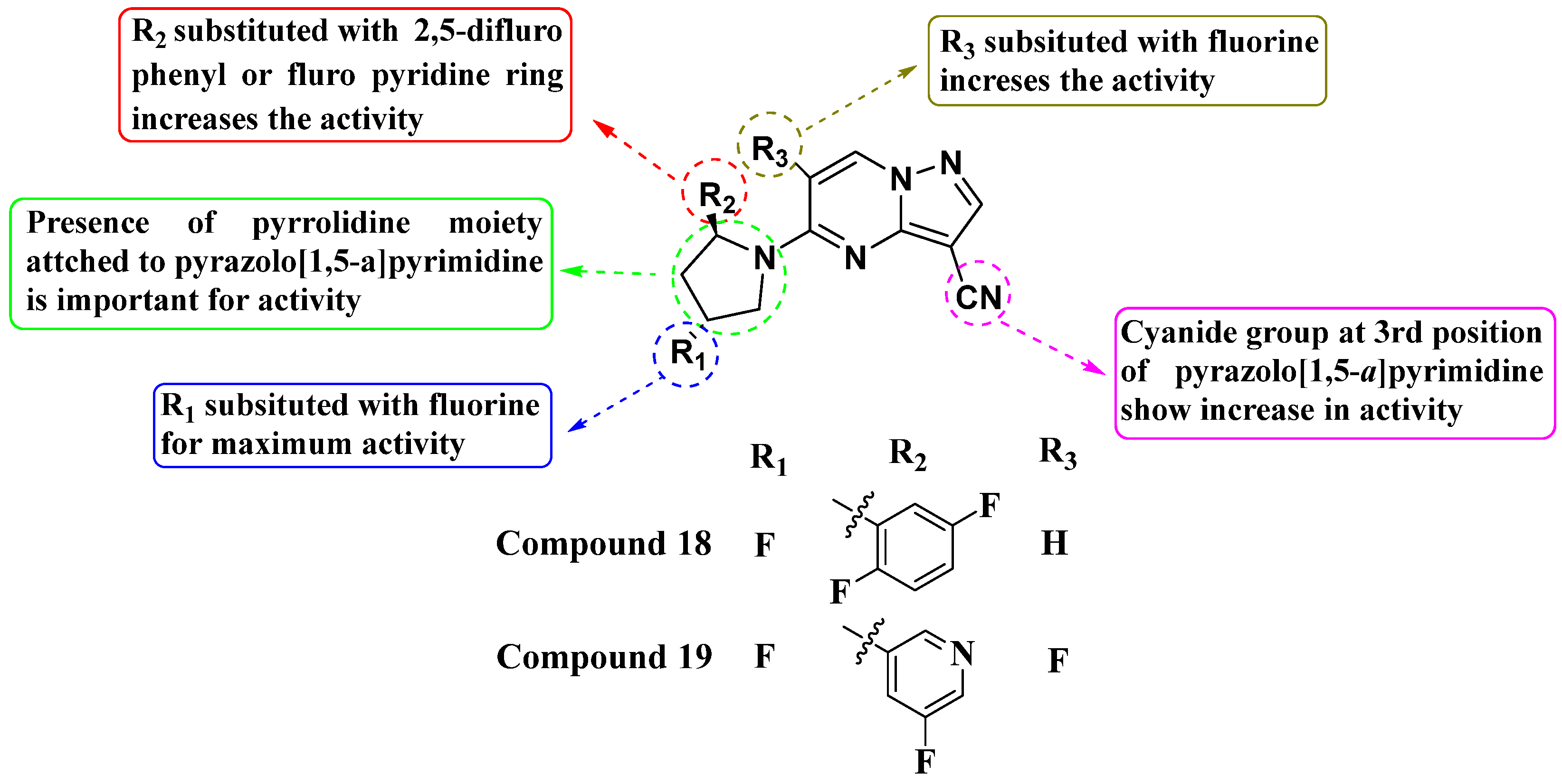


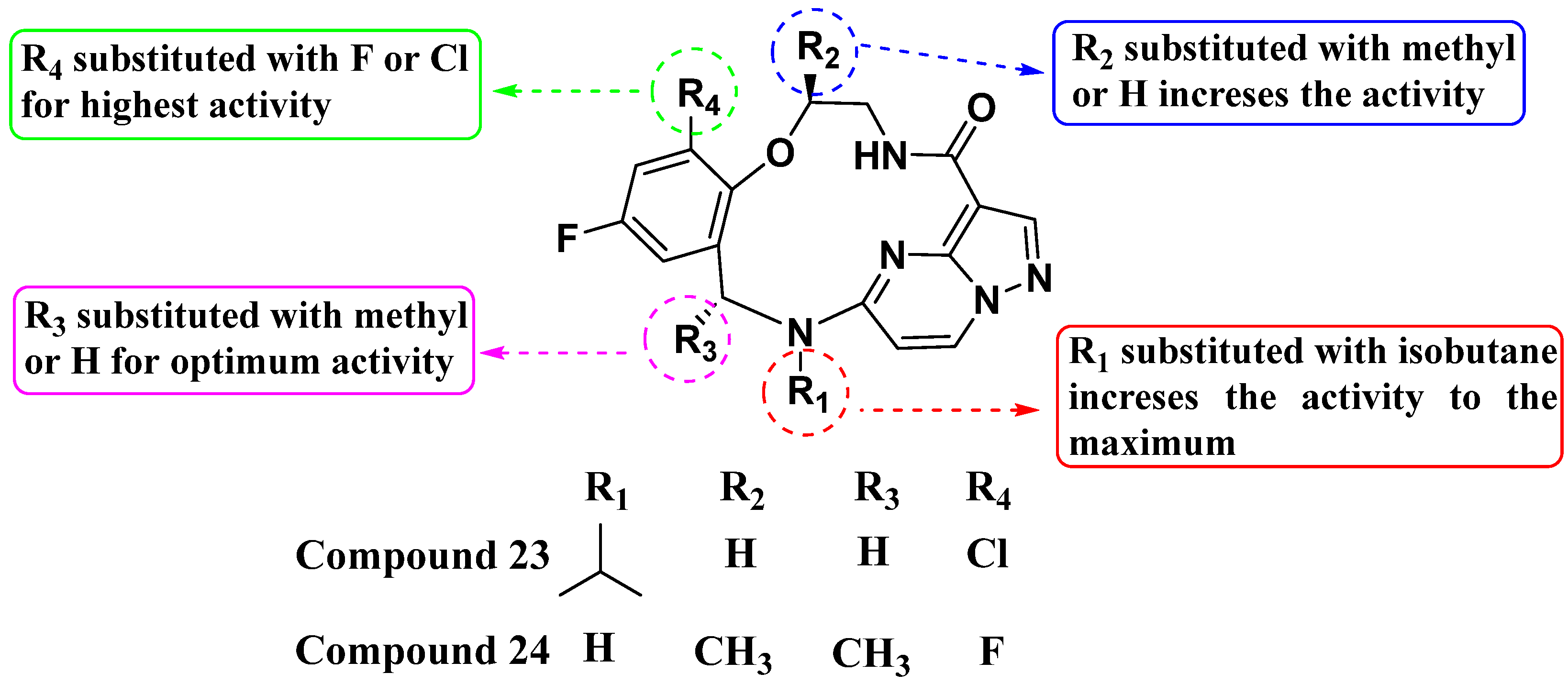




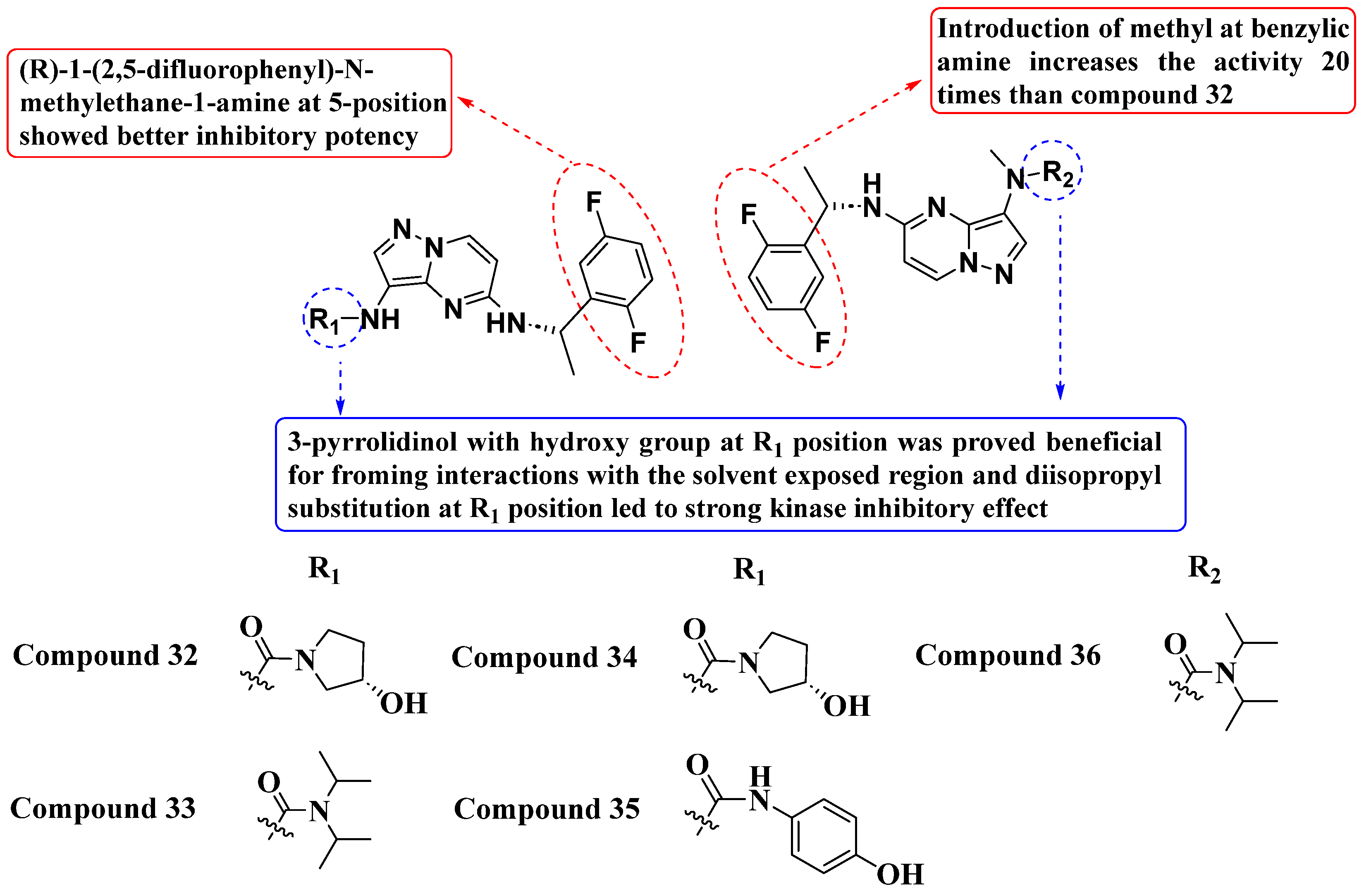
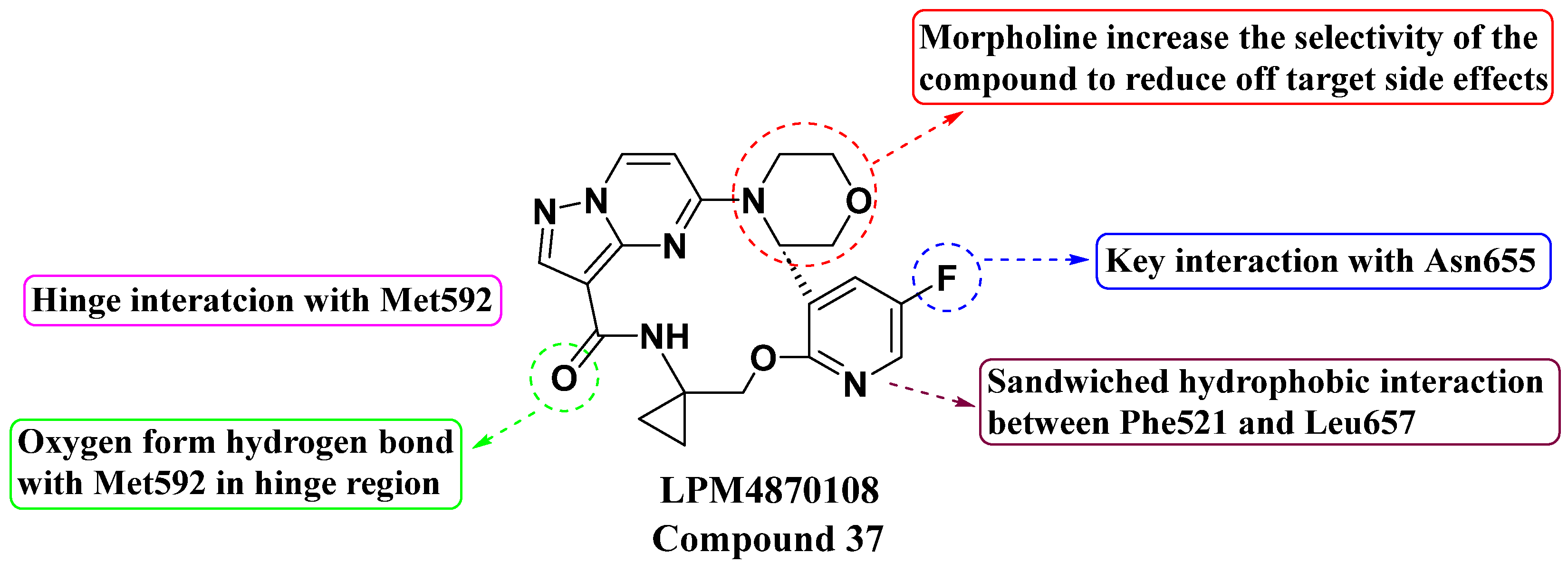
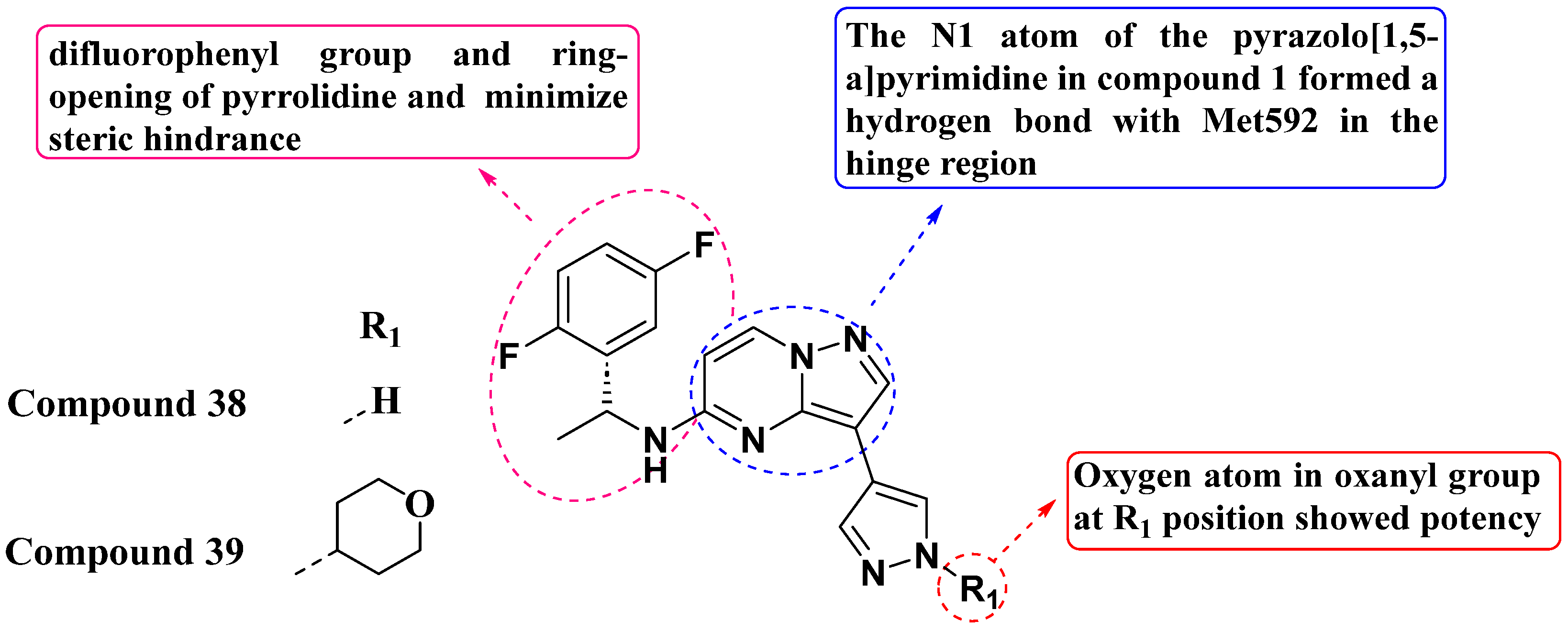



| Compd. No. | Chemical Structure | Chemical Structure Feature | IC50 Value |
|---|---|---|---|
| 8 | 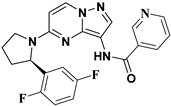 | The presence of a pp core with a 2,5-difluorophenyl-substituted pyrrolidine at the fifth position, along with an amide bond at the third position. | 1.7 nM |
| 10 |  | The presence of a pp core with a 2,5-difluoropyridine-substituted pyrrolidine at the fifth position, along with a hydroxyethyl acetamide at the third position. | 0.2 nM |
| 12 | 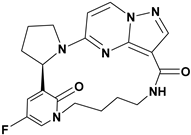 | The presence of a pp core with substituted pyrrolidine at the fifth position, along with a carboxamide at the third position forming a macrocyclic structure. | >100 nM |
| 14 |  | The presence of a pp core with a 2,5-difluorophenyl-substituted pyrrolidine at the fifth position, along with a thiadiazole bond at the third position. | >10 nM |
| 18 | 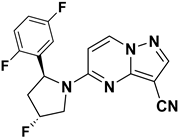 | The presence of a pp core with a 2,5-difluorophenyl-substituted pyrrolidine at the fifth position, along with cyanide at the third position. | >10 nM |
| 20 | 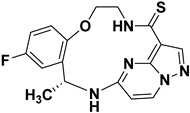 | The presence of a macrocyclic pp core with fluorophenyl attached to amine substituted at the fifth position, along with a carbothioamide at the third position. | >0.02 nM |
| 32 | 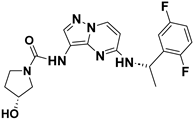 | The presence of a pp core with amine substituted at the fifth position, along with a pyrrolidine carboxamide at the third position. | 1.9 nM, 3.1 nM, 2.3 nM |
Disclaimer/Publisher’s Note: The statements, opinions and data contained in all publications are solely those of the individual author(s) and contributor(s) and not of MDPI and/or the editor(s). MDPI and/or the editor(s) disclaim responsibility for any injury to people or property resulting from any ideas, methods, instructions or products referred to in the content. |
© 2024 by the authors. Licensee MDPI, Basel, Switzerland. This article is an open access article distributed under the terms and conditions of the Creative Commons Attribution (CC BY) license (https://creativecommons.org/licenses/by/4.0/).
Share and Cite
Mahajan, A.T.; Shivani; Datusalia, A.K.; Coluccini, C.; Coghi, P.; Chaudhary, S. Pyrazolo[1,5-a]pyrimidine as a Prominent Framework for Tropomyosin Receptor Kinase (Trk) Inhibitors—Synthetic Strategies and SAR Insights. Molecules 2024, 29, 3560. https://doi.org/10.3390/molecules29153560
Mahajan AT, Shivani, Datusalia AK, Coluccini C, Coghi P, Chaudhary S. Pyrazolo[1,5-a]pyrimidine as a Prominent Framework for Tropomyosin Receptor Kinase (Trk) Inhibitors—Synthetic Strategies and SAR Insights. Molecules. 2024; 29(15):3560. https://doi.org/10.3390/molecules29153560
Chicago/Turabian StyleMahajan, Amol T., Shivani, Ashok Kumar Datusalia, Carmine Coluccini, Paolo Coghi, and Sandeep Chaudhary. 2024. "Pyrazolo[1,5-a]pyrimidine as a Prominent Framework for Tropomyosin Receptor Kinase (Trk) Inhibitors—Synthetic Strategies and SAR Insights" Molecules 29, no. 15: 3560. https://doi.org/10.3390/molecules29153560
APA StyleMahajan, A. T., Shivani, Datusalia, A. K., Coluccini, C., Coghi, P., & Chaudhary, S. (2024). Pyrazolo[1,5-a]pyrimidine as a Prominent Framework for Tropomyosin Receptor Kinase (Trk) Inhibitors—Synthetic Strategies and SAR Insights. Molecules, 29(15), 3560. https://doi.org/10.3390/molecules29153560






